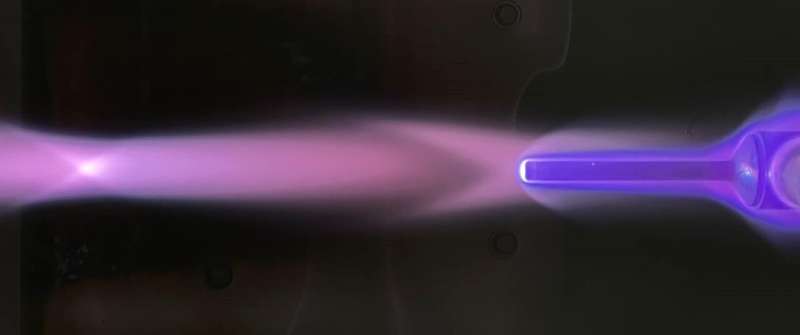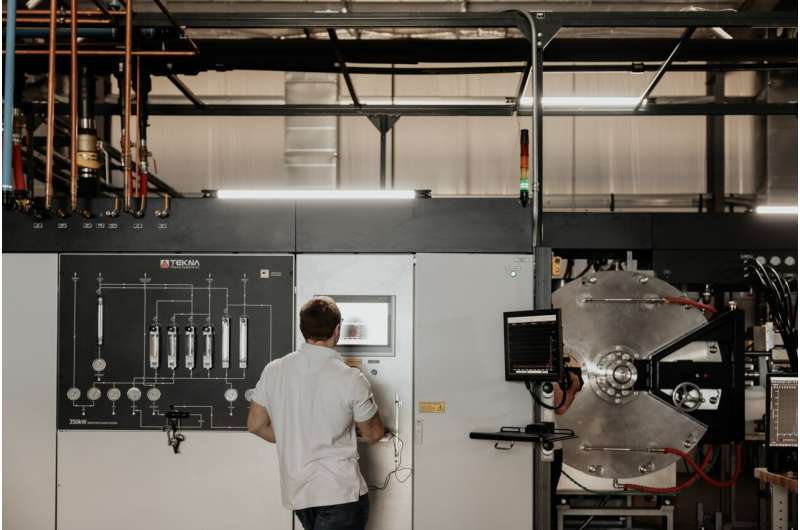New research facility houses largest plasma wind tunnel in the US

In hypersonic flight, an aircraft or spacecraft moves at least five times faster than the speed of sound—producing extreme heat that can push the craft beyond its physical limits. The difficulty and importance of protecting vehicles against those conditions were tragically illustrated in 2003 when slight damage to heat-shielding tiles caused the Space Shuttle Columbia to disintegrate while re-entering Earth's atmosphere.
A unique experimental facility at the University of Illinois Urbana-Champaign will help ensure that such a tragedy is never repeated—and enable unprecedented new adventures in space exploration.
The Plasmatron X is the largest inductively coupled plasma wind tunnel in the United States. Its purpose is to test materials to determine whether they can withstand the conditions that characterize extreme hypersonic flight by subjecting them to the intense heating encountered at high speeds.
A plasma wind tunnel is a facility in which energy is added to gas to the point that it ionizes and becomes plasma, mimicking the atmospheric conditions encountered in hypersonic flight. In an inductively coupled plasma wind tunnel, there is no contact between the high-temperature plasma and electrodes.
Francesco Panerai, an assistant professor in the Department of Aerospace Engineering and one of the leaders of the Plasmatron X effort, said pure flow created by contactless plasma generation is a big part of what makes the Plasmatron X a superior research tool. The absence of contact prevents contamination, creating "a pristine environment that is the same one that vehicles find when they travel high up in the atmosphere," he said. The result is a much better understanding of materials' behavior, enabling "materials-science-grade type of testing."

AE Professor Greg Elliott, who also plays a leading role with the Plasmatron X, noted that its size is another essential feature because larger samples and systems can be studied.
"It can also produce more heat—enthalpy—over a larger area, and we can run longer times, continuously, for hours. So we can provide an extreme environment for long test times and then change parameters to mimic different flight and re-entry conditions," Elliott said.
How extreme is Plasmatron X? The interior can reach temperatures of about 10,000 degrees Kelvin, compared to which the surface of the Sun, at a mere 5,778 degrees K, seems almost chilly. A severe cooling system, combined with the lack of contact between the plasma and interior walls, makes it possible to work safely with such high temperatures.
Aerospace Professor and Director of the Center for Hypersonics and Entry Systems Studies at Illinois Marco Panesi said, "the mission of CHESS is to address all the challenges of hypersonic flight." The Plasmatron X will be critical to that mission because thermal protection is "one of the weakest links" in hypersonic systems. "But we also do a lot of modeling and simulation for the flow and the plasma around the vehicle, radiation, and sensing," he said. The impossibility of directly measure all the quantity of interest to the design of hypersonic systems makes the high fidelity modeling of such environment critical to the operation of the high energy wind tunnels.
One of its first research projects is NASA's Dragonfly mission, sending a drone to search for life on Saturn's largest moon, Titan. Titan's atmosphere—about 95% nitrogen and 5% methane—is very different from Earth's. But that's no problem for the Plasmatron X, which, Elliott said, can simulate conditions for "any other atmospheres of planets or moons that you would want to have a re-entry system survive in."
Elliott said another reason for establishing this unique facility is to launch UIUC graduates into the world with a background that no one else can compete with. "That's our goal: that students go out there and have this unique capability to take the science further than we can imagine or dream about."
Provided by University of Illinois Dept. of Aerospace Engineering




















